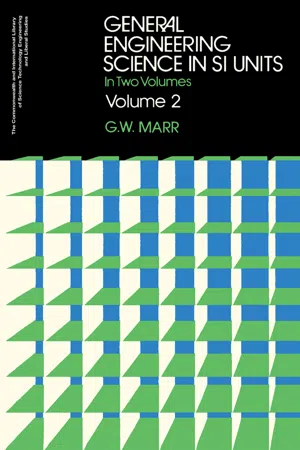
- 230 pages
- English
- PDF
- Available on iOS & Android
About this book
General Engineering Science in SI Units, Volume 2 covers the Engineering Science content of the General Course in Engineering, corresponding mainly to the requirements of the syllabus for the second year of a two-year course. This book discusses the resultant of a number of coplanar, concurrent forces; average velocity during uniformly accelerated motion; Newton's first law of motion; and graphical representation of the work done by a variable force. The load-extension graphs for brittle materials; coefficient of linear expansion of a solid; and electromotive force and potential difference are also elaborated. This publication likewise covers the magnetic effect of an electric current; rotation of a coil in a uniform magnetic field; and advantages and limitations of P.M.M.C. instruments. This volume is useful to students during the earlier years of CGLI Technician Courses and other engineering courses.
Frequently asked questions
- Essential is ideal for learners and professionals who enjoy exploring a wide range of subjects. Access the Essential Library with 800,000+ trusted titles and best-sellers across business, personal growth, and the humanities. Includes unlimited reading time and Standard Read Aloud voice.
- Complete: Perfect for advanced learners and researchers needing full, unrestricted access. Unlock 1.4M+ books across hundreds of subjects, including academic and specialized titles. The Complete Plan also includes advanced features like Premium Read Aloud and Research Assistant.
Please note we cannot support devices running on iOS 13 and Android 7 or earlier. Learn more about using the app.
Information
Table of contents
- Front Cover
- General Engineering Science in SI Units: In Two Volumes
- Copyright Page
- Table of Contents
- PREFACE
- USE OF DISTINGUISHING TYPE FOR SYMBOLS
- DRAWING SYMBOLS
- SECTION I. CONCURRENT FORCES
- SECTION II. VELOCITY AND ACCELERATION
- SECTION III. FORCE AND MOTION
- SECTION IV. POWER AND ENERGY
- SECTION V. STRENGTH OF MATERIALS
- SECTION VI. HEAT
- SECTION VII. ELECTRICITY
- SECTION VIII. ELECTROMAGNETISM
- SECTION IX. ELECTROMAGNETIC INDUCTION
- SECTION X. AMMETERS AND VOLTMETERS